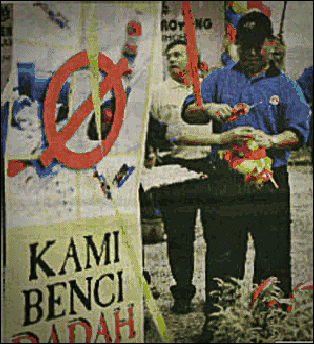Can we win the fight?
Dato' Dzulkifli Abd Razak
Article
- Comment - New Sunday Times - 03/12/2006
The ‘Belia Benci Dadah’ programme has only a slim chance to succeed like the ‘Tak Nak’ anti-smoking campaign.

ANTI-DRUGS CAMPAIGN: Government must first tackle
smoking among youths as this can lead to drugs.
AFTER the controversy over " Predator", the "date rape" drug, now we are faced with the "dance and sex" drug, according to the warning issued by the United Nations drug control agency last week.
While the "Predator" refers to drugs such as Rohypnol, GHB (gamma hydroxy butyrate) and ketamine hydrochloride, the dance and sex variety belongs to the group of amphetamine-type stimulants (ATS).
While the "Predator" renders the users incapable of asserting themselves and saying "no" to suggestions that can lead to sexual abuse such as rape, the ATS intends to keep the users wide awake for days. This can lead to violent behaviour, anxiety, mood swings, paranoia as well as fever, convulsions and self-harm.
It can cause death from an increase in blood pressure, resulting in the bursting of blood vessels in the brain and heart failure.
The London-based International Narcotics Control Board (INCB) has expressed concern about the spiralling use of one such ATS — methamphetamine or crystal meth. It is said to be more addictive than crack and cocaine, and is rapidly becoming a global problem.
Known as "ice", "meth", "Tina" and "Nazi crank", it is currently a cause for worry in North America.
The US authorities have since mid-2005 admitted that methamphetamine abuse has eclipsed all the other drug problems they face, including "old-fashioned" drugs such as cocaine.
INCB is calling for tougher restrictions on the chemicals used to make the drug, many of which are from common products such as fertilisers.
Malaysia must be very vigilant to this new danger.
Recently, the deputy director of Drug Abuse Prevention Education said there were 255,725 registered drug addicts based on pre-2005 records, while the Anti-Narcotics Agency recorded 290,000 addicts for 2005.
What a waste of human resource as a large proportion of the addicts are between the ages of 17 and 29. What a waste of money too as spending habits range from RM10 to RM100 a day, amounting to a staggering RM11 billion a year.
The Youth and Sports Minister has noted that lately, the country’s drug addicts are getting younger and the under-30 group is also most likely to be the target of meth-attacks.
Seven of the 10 addicts in Malaysia are in the 13-39 age bracket, according to the ministry, with about 80 per cent of the drug addicts being school dropouts.
While all of these are not really new given that the drug menace has been with us for more than three decades, what is new perhaps is the next wave of drugs that will hit our shores. Here, some new thinking is urgently needed to combat the menace.
The ministry has already allocated RM1 million to assist the drug abuse prevention programme in institutions of higher learning as part of a Belia Benci Dadah (Youth Hate Drugs) programme launched recently.
In conjunction with this, some 2,000 billboards will be erected in public universities and private colleges as a reminder about the dangers of taking drugs.
The ministry feels that when students are fully aware of the issue, they can assist the Government in eradicating drugs,
Previously there was even a slogan, "Drug-free campus by 2008!"
Of course, eliminating the drug scourge is not an easy task. At least not by 2008, even in campuses.
It would definitely take more than RM1 million and more than 2,000 billboards to have a significant impact.
The tobacco abuse eradication Tak Nak campaign, despite being more pervasive and backed up with a large financial allocation, proved to be a failure.
There is only a slim likelihood that the Belia Benci Dadah campaign can do any better.
It seems we are "hooked" to the old ways of campaigning against drugs although they have been proven time and again to be ineffective.
In contrast, the merchants of death have been more creative in expanding their lucrative trade, the tobacco industry included.
But all is not lost. The Minister of Youth and Sports was quoted recently as saying: "Youths start off with self-rolled cigarettes, then they move on and try Ecstasy pills and before you know it, they are doing drugs for good." (NST, Feb. 12).
This being the case, a better strategy in the fight against drug abuse is to begin with the war against smoking which is more prevalent in campuses
